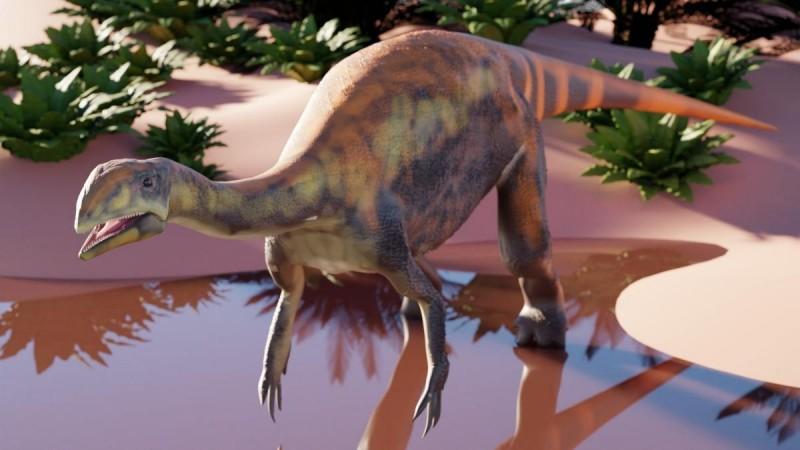It is difficult to envisage what life on Earth might have been like if the Chicxulub impactor had not brought the existence of dinosaurs to an abrupt and cataclysmic end. However, the unearthing of new species provides a glimpse into the rich diversity of the reptiles that dominated the planet millions of years ago. Offering such a peek into the past, scientists have reported the discovery of a new dinosaur in Greenland.
In a multi-institutional study, researchers have described a new two-legged herbivorous dinosaur. Paying tribute to Greenland's Inuit language, the species has been named Issi saaneq, which means "cold bone". Issi saaneq lived in what is now Greenland around 214 million years ago during the Late Triassic Period (235-201 million years ago).
"It is the northernmost record of a Late Triassic sauropodomorph, and a new dinosaur species erected for Greenland. Issi saaneq broadens our knowledge about the evolution of plateosaurid sauropodomorphs," wrote the authors. The findings were published in the journal Diversity.
Predecessor of Giants

Issi saaneq belongs to a clade (or subgroup) of dinosaurs known as Sauropodomorpha. Within Sauropodomorpha, it is a member of a family called Plateosauridae. Known as plateosaurids, the family is composed of two genera—Plateosaurus and Yimenosaurus—and the species Euskelosaurus.
Plateosaurids had long necks and tails, were medium-sized (9 ft-33 ft in length; weighing 1,300-8,000 lbs), and were mostly bipedal. However, this was a stark contrast to sauropods, to whom plateosaurids are predecessors. While sauropods also possessed long necks and tails, they were quadrupedal, grew to massive sizes (16 ft-135 ft in length; weighing up to 155,000 lbs), and are considered to be among the largest land-living animals to have existed.
'Cold bone' lived at an important time in the history of herbivorous dinosaurs. During the Late Triassic Period, the supercontinent Pangaea began breaking apart and the formation of the Atlantic Ocean commenced. "At the time, the Earth was experiencing climate changes that enabled the first plant-eating dinosaurs to reach Europe and beyond," said Dr. Lars Clemmensen, corresponding author of the study, in a statement.
A New Species

The remains of Issi saaneq—which consisted of two well-preserved skulls—were unearthed by paleontologists during an excavation in 1994 in the Malmros Klint Formation, Jameson Land, East Greenland. Initially, one of the skulls was assumed to be that of a Plateosaurus, a fellow plateosaurid that roamed France, Germany, and Switzerland throughout the Triassic era.
For the study, the bones of 'cold bone' were submitted to micro-CT scanning by the team. This aided them in creating 3D models of not only the bones—that were still covered in sediments—but also the internal structures. It was learnt that the two skulls indeed belonged to an entirely new species. Issi saaneq is estimated to have been13 ft in length, 5 ft in height, and weighed up to 2,200 lbs.
![Topographic map of Jameson Land, central East Greenland. (A) Topographic map of Jameson Land. The Macknight Bjerg site of the Malmros Klint Formation is marked by the red circle and number 2. Modified from [25]. (B) Photograph of the outcrops in Buch Bjerg New Dinosaur](https://data1.ibtimes.co.in/en/full/767083/new-dinosaur.jpg?h=450&l=50&t=40)
While one of the skulls was from a middle-stage juvenile, the other was from a late-stage juvenile (subadult). Other than size, the differences observed between the two skulls with respect to the bone structure were minor and were limited only to proportions.
"The anatomy of the two skulls is unique in many respects, for example in the shape and proportions of the bones. These specimens certainly belong to a new species," explained Dr. Victor Beccari, lead author of the study.
Diversity of Species

As of now, only a handful of dinosaur finds from East Greenland have been prepared and well-documented. The discovery of Issi saaneq serves as evidence of the existence of a distinct Greenlandic dinosaur species.
While Issi saaneq significantly differs from all the other sauropodomorphs discovered so far, the authors stated that it bore resemblance to dinosaurs such as Macrocollum and Unaysaurus that have been unburied in Brazil. Interestingly, these species are older by nearly 15 million years.
Along with adding diversity to the range of reptilian species that flourished in the Late Triassic period, the unearthing of 'cold bone' provides an improved understanding of the evolutionary chains and timeline of sauropods that flourished on Earth for approximately 150 million years.
Talking about the significance of Issi saaneq's identification, Dr. Oliver Wings, co-author of the study expressed, "It is exciting to discover a close relative of the well-known Plateosaurus, more than one hundred of which have already been found here in Germany." Upon the completion of scientific evaluation, the fossils will be housed in the Natural History Museum of Denmark.

















